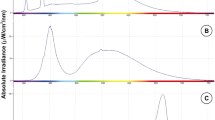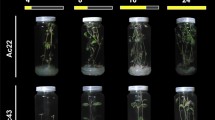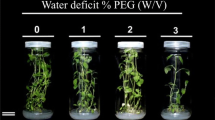Abstract
Interactions between circadian clock regulation and metabolic responses are believed to explain the importance of rhythmic behavior in plant growth and survival. Lippia alba is an important species because of the medicinal properties of its essential oil extract. The objective of this work was to evaluate the effect of photoperiod on anatomy, growth, essential oil profile, and the expression of genes related to the synthesis of monoterpenes, sesquiterpenes, and the circadian clock in L. alba grown in vitro. The plants were cultured in vitro under different photoperiods (4, 8, 16, and 24 h of light) and irradiance of 41 μmol m−2 s−1. After 40 days of culture, results showed that L. alba presented high physiological plasticity under different photoperiods, with improved performance when exposed to continuous light. The best growth; anatomical organization of the mesophyll, stem, roots, and bundles; amount of photosynthetic pigments; photosynthetic rate; and protein synthesis occurred under a photoperiod of 24 h. The biosynthesis of linalool, the major compound, was increased under the 24-h photoperiod, possibly due to reduced geraniol synthesis. These findings allow a better understanding of how photoperiod acts in the regulation of primary and secondary metabolism, and especially with regard to the composition of essential oils.
Key message
Photoperiod modulates primary metabolism, growth, morphoanatomy, photosynthesis, and essential oil content in the medicinal plant Lippia alba cultured in vitro under 4, 8, 16 or 24 h of light.








Similar content being viewed by others
References
Adams RP (1997) Identification of essential oil components by gas chromatography/mass spectroscopy. J Am Soc Mass Spectrom 6:671–672
Alabadí D, Oyama T, Yanovsky MJ, Harmon FG, Más P, Kay SA (2001) Reciprocal regulation between TOC1 and LHY/CCA1 within the Arabidopsis circadian clock. Science 293:880–883. https://doi.org/10.1126/science.1061320
Amin B, Hosseinzadeh H (2016) Black cumin (Nigella sativa) and its active constituent, thymoquinone: an overview on the analgesic and anti-inflammatory effects. Planta Med 82:8–16. https://doi.org/10.1055/s-0035-1557838
Baerenfaller K, Massonnet C, Hennig L, Russenberger D, Sulpice R, Walsh S, Stitt M, Granier C, Gruissem W (2015) A long photoperiod relaxes energy management in Arabidopsis leaf six. Curr Plant Biol 2:34–45. https://doi.org/10.1016/j.cpb.2015.07.001
Barbosa QP, da Câmara CA, Ramos CS, Nascimento DC, Lima-Filho JV, Guimarães EF (2012) Chemical composition, circadian rhythm and antibacterial activity of essential oils of Piper divaricatum: a new source of safrole. Quím Nova 35:1806–1808. https://doi.org/10.1590/S0100-40422012000900019
Barros PM, Cherian S, Costa M, Sapeta H, Saibo NJM, Oliveira MM (2017) The identification of almond GIGANTEA gene and its expression under cold stress, variable photoperiod, and seasonal dormancy. Biol Plant 61:631–640. https://doi.org/10.1007/s10535-017-0711-1
Batista DS, Castro KM, Silva AR, Teixeira ML, Sales TA, Soares LI, Cardoso MG, Santos MO, Viccini LF, Otoni WC (2016) Light quality affects in vitro growth and essential oil profile in Lippia alba (Verbenaceae). In Vitro Cell Dev Biol-Plant 52:276–282. https://doi.org/10.1007/s11627-016-9761-x
Batista DS, Castro KM, Koehler AD, Porto BN, Silva AR, Souza VC, Teixeira ML, Cardoso MG, Santos MO, Viccini LF, Otoni WC (2017a) Elevated CO2 improves growth, modifies anatomy, and modulates essential oil qualitative production and gene expression in Lippia alba (Verbenaceae). Plant Cell Tiss Organ Cult 128:357–368. https://doi.org/10.1007/s11240-016-1115-1
Batista DS, Dias LLC, Rêgo MMD, Saldanha CW, Otoni WC (2017b) Flask sealing on in vitro seed germination and morphogenesis of two types of ornamental pepper explants. Ciên Rural 47:1–6. https://doi.org/10.1590/0103-8478cr20150245
Benelli G, Pavela R, Giordani C, Casettari L, Curzi G, Cappellacci L, Petrelli R, Maggi F (2018) Acute and sub-lethal toxicity of eight essential oils of commercial interest against the filariasis mosquito Culex quinquefasciatus and the housefly Musca domestica. Ind Crops Prod 112:668–680. https://doi.org/10.1016/j.indcrop.2017.12.062
Bilger W, Bjorkman O (1990) Role of the xanthophyll cycle in photoprotection elucidated by measurements of light-induced absorbance changes, fluorescence and photosynthesis in leaves of Hedera canariensis. Photosynth Res 25:173–185. https://doi.org/10.1007/BF00033159
Böhme K, Barros-Velázquez J, Calo-Mata P, Aubourg SP (2014) Antibacterial, antiviral and antifungal activity of essential oils: mechanisms and applications. Antimicrobial compounds. In: Villa T, Veiga-Crespo P (eds) Antimicrobial compounds. Springer, Berlin, pp 51–81
Bordage S, Sullivan S, Laird J, Millar AJ, Nimmo HG (2016) Organ specificity in the plant circadian system is explained by different light inputs to the shoot and root clocks. New Phytol 212:136–149. https://doi.org/10.1111/nph.14024
Castro EM, Pinto JEBP, Melo HCD, Soares AM, Alvarenga AA, Lima Júnior EC (2005) Aspectos anatômicos e fisiológicos de plantas de guaco submetidas a diferentes fotoperíodos. Hortic Bras 23:846–850. https://doi.org/10.1590/S0102-05362005000300031
Carvalho IS, Cavaco T, Carvalho LM, Duque P (2010) Effect of photoperiod on flavonoid pathway activity in sweet potato (Ipomoea batatas (L.) Lam.) leaves. Food Chem 118:384–390. https://doi.org/10.1016/j.foodchem.2009.05.005
Chen JW, Bai KD, Cao KF (2009) Inhibition of monoterpene biosynthesis accelerates oxidative stress and leads to enhancement of antioxidant defenses in leaves of rubber tree (Hevea brasiliensis). Acta Physiol Plant 31:95. https://doi.org/10.1007/s11738-008-0205-z
Costa AC, Rosa M, Megguer CA, Silva FG, Pereira FG, Otoni WC (2014) A reliable methodology for assessing the in vitro photosynthetic competence of two Brazilian savanna species: Hyptis marrubioides and Hancornia speciosa. Plant Cell Tiss Organ Cult 117(3):443–454. https://doi.org/10.1007/s11240-014-0455-y
Cross JM, Von Korff M, Altmann T, Bartzetko L, Sulpice R, Gibon Y, Palacios N, Stitt M (2006) Variation of enzyme activities and metabolite levels in 24 Arabidopsis accessions growing in carbon-limited conditions. Plant Physiol 142:1574–1588. https://doi.org/10.1104/pp.106.086629
Cruz CD (2016) Genes software-extended and integrated with the R, Matlab and Selegen. Acta Sci Agron 38:547–552. https://doi.org/10.4025/actasciagron.v38i4.32629
Dodd AN, Salathia N, Hall A, Kévei E, Tóth R, Nagy F, Hibberd JM, Millar AJ, Webb AAR (2005) Plant circadian clocks increase photosynthesis, growth, survival, and competitive advantage. Science 309:630–633. https://doi.org/10.1126/science.1115581
Farré EM, Harmer SL, Harmon FG, Yanovsky MJ, Kay SA (2005) Overlapping and distinct roles of PRR7 and PRR9 in the Arabidopsis circadian clock. Curr Biol 15:47–54
Fernie AR, Roscher A, Ratcliffe RG, Kruger NJ (2001) Fructose 2,6-bisphosphate activates pyrophosphate: fructose-6-phosphate 1-phosphotransferase and increases triose phosphate to hexose phosphate cycling in heterotrophic cells. Planta 212:250–263. https://doi.org/10.1007/s004250000386
Fréchette E, Chang CYY, Ensminger I (2016) Photoperiod and temperature constraints on the relationship between the photochemical reflectance index and the light use efficiency of photosynthesis in Pinus strobus. Tree Physiol 36:311–324. https://doi.org/10.1093/treephys/tpv143
Gendron JM, Pruneda-Paz JL, Doherty CJ, Gross AM, Kang SE, Kay SA (2012) Arabidopsis circadian clock protein, TOC1, is a DNA-binding transcription factor. Proc Natl Acad Sci 109:3167–3172. https://doi.org/10.1073/pnas.1200355109
Hädrich N, Hendriks JH, Kötting O, Arrivault S, Feil R, Zeeman SC, Gibon Y, Schulze WX, Stitt M, Lunn JE (2012) Mutagenesis of cysteine 81 prevents dimerization of the APS1 subunit of ADP-glucose pyrophosphorylase and alters diurnal starch turnover in Arabidopsis thaliana leaves. Plant J 70:231–242. https://doi.org/10.1111/j.1365-313X.2011.04860.x
Harmer SL, Hogenesch JB, Straume M, Chang HS, Han B, Zhu T, Wang X, Kreps JA, Kay SA (2000) Orchestrated transcription of key pathways in Arabidopsis by the circadian clock. Science 290:2110–2113. https://doi.org/10.1126/science.290.5499.2110
Haydon MJ, Hearn TJ, Bell LJ, Hannah MA, Webb AA (2013) Metabolic regulation of circadian clocks. Semin Cell Dev Biol 24:414–421. https://doi.org/10.1016/j.semcdb.2013.03.007
Hennebelle T, Sahpaz S, Joseph H, Bailleul F (2008) Ethnopharmacology of Lippia alba. J Ethnopharmacol 116:211–222. https://doi.org/10.1016/j.jep.2007.11.044
Hsie BS, Bueno AIS, Bertolucci SKV, Carvalho AA, Cunha SHB, Martins ER, Pinto JEBP (2019) Study of the influence of wavelengths and intensities of LEDs on the growth, photosynthetic pigment, and volatile compounds production of Lippia rotundifolia Cham in vitro. J Photochem Photobiol B 198:111577. https://doi.org/10.1016/j.jphotobiol.2019.111577
Huang W, Pérez-García P, Pokhilko A, Millar AJ, Antoshechkin I, Riechmann JL, Mas P (2012) Mapping the core of the Arabidopsis circadian clock defines the network structure of the oscillator. Science 336:75–79. https://doi.org/10.1126/science.1219075
Ito S, Kawamura H, Niwa Y, Nakamichi N, Yamashino T, Mizuno T (2009) A genetic study of the Arabidopsis circadian clock with reference to the timing of cab expression 1 (TOC1) gene. Plant Cell Physiol 50:290–303. https://doi.org/10.1093/pcp/pcn198
Karnovsky MJ (1965) A formaldehyde glutaraldehyde fixative of high osmolality for use in electron microscopy. J Cell Biol 27:137
Kooten O, Snel JFH (1990) The use of chlorophyll fluorescence nomenclature in plant stress physiology. Photosynth Res 25(3):147–150
Lazzarini LES, Bertolucci SKV, Pacheco FV, Santos J, Silva ST, Carvalho AA, Pinto JEBP (2018) Quality and intensity of light affect Lippia gracilis Schauer plant growth and volatile compounds in vitro. Plant Cell Tiss Organ Cult 135:367–379. https://doi.org/10.1007/s11240-018-1470-1
Livak KJ, Schmittgen TD (2001) Analysis of relative gene expression data using real-time quantitative PCR and the 2−ΔΔCT method. Methods 25:402–408. https://doi.org/10.1006/meth.2001.1262
Loivamäki M, Louis S, Cinege G, Zimmer I, Fischbach RJ, Schnitzler JP (2007) Circadian rhythms of isoprene biosynthesis in grey poplar leaves. Plant Physiol 143:540–551. https://doi.org/10.1104/pp.106.092759
Lorenzi H, Matos FJA (2008) Plantas medicinais no Brasil—nativas e exóticas. Instituto Plantarum de Estudos da Flora, Nova Odessa, p 512p
Lu SX, Knowles SM, Andronis C, Ong MS, Tobin EM (2009) Circadian clock associated1 and late elongated hypocotyl function synergistically in the circadian clock of arabidopsis. Plant Physiol 150:834–843. https://doi.org/10.1104/pp.108.133272
Mahmud KP, Holzapfel BP, Guisard Y, Smith JP, Nielsen S, Rogiers SY (2018) Circadian regulation of grapevine root and shoot growth and their modulation by photoperiod and temperature. J Plant Physiol 222:86–93. https://doi.org/10.1016/j.jplph.2018.01.006
Maurya JP, Bhalerao RP (2017) Photoperiod and temperature-mediated control of growth cessation and dormancy in trees: a molecular perspective. Ann Bot 120:351–360. https://doi.org/10.1093/aob/mcx061
Maxwell K, Johnson GN (2000) Chlorophyll fluorescence—a practical guide. J Exp Bot 51:659–668. https://doi.org/10.1093/jexbot/51.345.659
Mengin V, Pyl ET, Moraes TA, Sulpice R, Krohn N, Encke B, Stitt M (2017) Photosynthate partitioning to starch in Arabidopsis thaliana is insensitive to light intensity but sensitive to photoperiod due to a restriction on growth in the light in short photoperiods. Plant Cell Environ 40:2608–2627. https://doi.org/10.1111/pce.13000
Morais LAS (2009) Influência dos fatores abióticos na composição química dos óleos essenciais. Hortic Bras 27:50–63. http://www.abhorticultura.com.br/eventosx/trabalhos/ev_3/P_4_Palestra_Resumo_Lilia_Ap.pdf. Accessed 10 Jan 2019
Murashige T, Skoog F (1962) A revised medium for rapid growth and bio assays with tobacco tissue cultures. Physiol Plant 15:473–497. https://doi.org/10.1111/j.1399-3054.1962.tb08052.x
Nakamichi N, Kiba T, Henriques R, Mizuno T, Chua NH, Sakakibara H (2010) Pseudo-response regulators 9, 7, and 5 are transcriptional repressors in the Arabidopsis circadian clock. Plant Cell 22:594–605. https://doi.org/10.1105/tpc.109.072892
Nusinow DA, Helfer A, Hamilton EE, King JJ, Imaizumi T, SchultzTF Kay SA (2011) The ELF4-ELF3-LUX complex links the circadian clock to diurnal control of hypocotyl growth. Nature 475:398. https://doi.org/10.1038/nature10182
O’Brien TP, McCully ME (1981) The study of plant structure: principles and selected methods. Melbourne, Termarcarphi Pty. Ltd, https://doi.org/10.2307/1219725
Otoni CG, Espitia PJ, Avena-Bustillos RJ, McHugh TH (2016) Trends in antimicrobial food packaging systems: emitting sachets and absorbent pads. Food Res Int 83:60–73. https://doi.org/10.1016/j.foodres.2016.02.018
Park DH, Somers DE, Kim YS, Choy YH, Lim HK, Soh MS, Kim HJ, Kay SA, Nam HG (1999) Control of circadian rhythms and photoperiodic flowering by the Arabidopsis GIGANTEA gene. Science 285:1579–1582. https://doi.org/10.1126/science.285.5433.1579
Pascual ME, Slowing K, Carretero E, Sánches Mata D, Villar A (2001) Lippia: traditional uses, chemistry and pharmacology: a review. J Ethnopharmacol 76:201–214. https://doi.org/10.1016/S0378-8741(01)00234-3
Pavela R, Govindarajan M (2017) The essential oil from Zanthoxylum monophyllum a potential mosquito larvicide with low toxicity to the non-target fish Gambusia affinis. J Pest Sci 90:369–378. https://doi.org/10.1007/s10340-016-0763-6
Peng Y, Li Y (2014) Combined effects of two kinds of essential oils on physical, mechanical and structural properties of chitosan films. Food Hydrocoll 36:287–293. https://doi.org/10.1016/j.foodhyd.2013.10.013
Pola CC, Medeiros EA, Pereira OL, Souza VG, Otoni CG, Camilloto GP, Soares NF (2016) Cellulose acetate active films incorporated with oregano (Origanum vulgare) essential oil and organophilic montmorillonite clay control the growth of phytopathogenic fungi. Food Pack Shelf Life 9:69–78. https://doi.org/10.1016/j.fpsl.2016.07.001
Proestos C, Lytoudi K, Mavromelanidou OK, Zoumpoulakis P, Sinanoglou VJ (2014) Antioxidant capacity of selected plant extracts and their essential oils. Antioxidants 2:11–22. https://doi.org/10.3390/antiox2010011
Ragagnin RCG, Albuquerque CC, Oliveira FFM, Santos RG, Gurgel EP, Diniz JC, Viana FA (2014) Effect of salt stress on the growth of Lippia gracilis Schauer and on the quality of its essential oil. Acta Bot Brasilica 28:346–351. https://doi.org/10.1590/0102-33062014abb3369
Raut JS, Karuppayil SM (2014) A status review on the medicinal properties of essential oils. Ind Crops Prod 62:250–264. https://doi.org/10.1016/j.indcrop.2014.05.055
Reis AC, Sousa SM, Vale AA, Pierre PMO, Franco AL, Campos JMS, Vieira RF, Viccini LF (2014) Lippia alba (Mill.) NE Br. (Verbenaceae): a new tropical autopolyploid complex? Am J Bot 101:1002–1012. https://doi.org/10.3732/ajb.1400149
Saljoughian S, Shahin R, Alaa El-Din AB, Ralf G, Alireza O, Nooshin N, Amin MK (2018) The effects of food essential oils on cardiovascular diseases: a review. Crit Rev Food Sci Nutr 58:1688–1705. https://doi.org/10.1080/10408398.2017.1279121
Schneider CA, Rasband WS, Eliceiri KW (2012) NIH Image to ImageJ: 25 years of image analysis. Nat Methods 9:671–675. https://doi.org/10.1038/nmeth.2089
Serrano-Bueno G, Romero-Campero FJ, Lucas-Reina E, Romero JM, Valverde F (2017) Evolution of photoperiod sensing in plants and algae. Curr Opin Plant Biol 37:10–17. https://doi.org/10.1016/j.pbi.2017.03.007
Shibaeva TG, Markovskaya EF (2013) Growth and development of cucumber Cucumis sativus L. in the prereproductive period under long photoperiods. Russ J Dev Biol 44:278–285. https://doi.org/10.1134/S1062360413020082
Shin J, Sánchez-Villarreal A, Davis AM, Du SX, Berendzen KW, Koncz C, Ding Z, Li C, Davis SJ (2017) The metabolic sensor AKIN10 modulates the Arabidopsis circadian clock in a light-dependent manner. Plant Cell Environ 40:997–1008. https://doi.org/10.1111/pce.12903
Song YH, Kubota A, Kwon MS, Covington MF, Lee N, Taagen ER, Laboy Cintrón D, Hwang DY, Akiyama R, Hodge SK, Huang H, Nguyen NH, Nusinow DA, Millar AJ, Shimizu KK, Imaizumi T (2018) Molecular basis of flowering under natural long-day conditions in Arabidopsis. Nat Plants 4:824–835. https://doi.org/10.1038/s41477-018-0253-3
Szczepanski S, Lipski A (2014) Essential oils show specific inhibiting effects on bacterial biofilm formation. Food Control 36:224–229. https://doi.org/10.1016/j.foodcont.2013.08.023
Triozzi PM, Ramos-Sánchez JM, Hernández-Verdeja T, Moreno-Cortés A, Allona I, Perales M (2018) Photoperiodic regulation of shoot apical growth in poplar. Front Plant Sci 9:1030. https://doi.org/10.3389/fpls.2018.01030
Viccini LF, Pierre PMO, Praça MM, Souza-Costa DC, Costa Romanel E, Sousa SM, Peixoto PHP, Salimena FRG (2006) Chromosome numbers in the genus Lippia (Verbenaceae). Plant System Evol 256:171–178. https://doi.org/10.1007/s00606-005-0351-3
Viccini LF, Silveira RS, Vale AA, Campos JMS, Reis AC, Santos MO, Campos VR, Carpanez AG, Grazul RM (2014) Citral and linalool content has been correlated to DNA content in Lippia alba (Mill.) NE Brown (Verbenaceae). Ind Crops Prod 59:14–19. https://doi.org/10.1016/j.indcrop.2014.04.028
Vogg G, Heim R, Hansen J, Schäfer C, Beck E (1998) Frost hardening and photosynthetic performance of Scots pine (Pinus sylvestris L.) needles. I. Seasonal changes in the photosynthetic apparatus and its function. Planta 204:193–200. https://doi.org/10.1007/s004250050246
Wagas KK, ErumD Tanveer A, HammadI Bushra M (2016) Evaluation of Ajuga bracteosa for antioxidant, anti-inflammatory, analgesic, antidepressant and anticoagulant activities. BMC Complem Altern Med 16:375. https://doi.org/10.1186/s12906-016-1363-y
Wang L, Han F, Zheng HQ (2018) Photoperiod-controlling guttation and growth of rice seedlings under microgravity on board Chinese spacelab TG-2. Microgravity Sci Technol 30:839–847. https://doi.org/10.1007/s12217-018-9644-3
Wei Y, Qian-liang M, Bing L, Khalid R, Cheng-Jian Z, Ting H, Lu-ping Q (2016) Medicinal plant cell suspension cultures: pharmaceutical applications and high-yielding strategies for the desired secondary metabolites. Crit Rev Biotechnol 36:215–232. https://doi.org/10.3109/07388551.2014.923986
Welburn AR (1994) The spectral determination of chlorophylls a and b, as well as total carotenoids, using various solvents with spectrophotometers of different resolution. J Plant Physiol 144:307–313. https://doi.org/10.1016/S0176-1617(11)81192-2
Zuo Z, Wang B, Ying B, Zhou L, Zhang R (2017) Monoterpene emissions contribute to thermotolerance in Cinnamomum camphora. Trees 31:1759–1771. https://doi.org/10.1007/s00468-017-1582-y
Acknowledgements
The authors thank the Conselho Nacional de Desenvolvimento Científico e Tecnológico (CNPq, DF, Brazil; grants 432412/2016-6 and 313740/2017-8 to LFV), and Coordenação de Aperfeiçoamento de Pessoal de Ensino Superior, CAPES, DF, Brazil; Finance Code 001), for financial support. Dr. Roberto Fontes Vieira (Embrapa Recursos Genéticos e Biotecnologia—Embrapa/Cenargen, Brasília, DF, Brazil) is also acknowledged for providing the Lippia alba accession. We would like to thank Editage (www.editage.com) for English language editing.
Author information
Authors and Affiliations
Contributions
KMC, DSB and WCO conceived and designed the experiments; KMC, TDS, EAF and SHSF performed the experiments, collected and analyzed the data; KMC, TDS, EAF, SHSF and RMJS performed the anatomical, physiological and biochemical analyses; LSQN, VRC and RMG carried out the microextraction and qualitative analysis of essential oils; DSB performed the gene expression analysis by RT-qPCR; KMC and DSB performed the statistical analysis; KMC, DSB, AMF, RMG, LFV and WCO contributed to the interpretation of the research and to the writing of the paper. All authors read and approved the manuscript.
Corresponding author
Ethics declarations
Conflict of interest
The authors declare no conflict of interest.
Additional information
Communicated by Mohammad Faisal.
Publisher's Note
Springer Nature remains neutral with regard to jurisdictional claims in published maps and institutional affiliations.
Rights and permissions
About this article
Cite this article
de Castro, K.M., Batista, D.S., Fortini, E.A. et al. Photoperiod modulates growth, morphoanatomy, and linalool content in Lippia alba L. (Verbenaceae) cultured in vitro. Plant Cell Tiss Organ Cult 139, 139–153 (2019). https://doi.org/10.1007/s11240-019-01672-w
Received:
Accepted:
Published:
Issue Date:
DOI: https://doi.org/10.1007/s11240-019-01672-w




